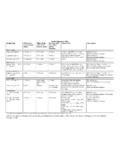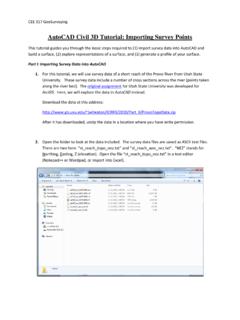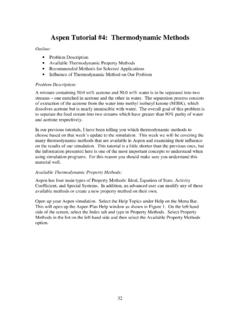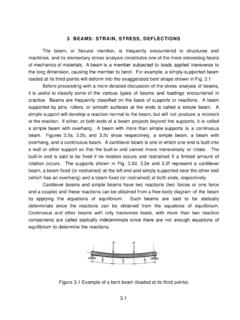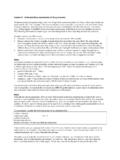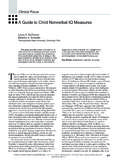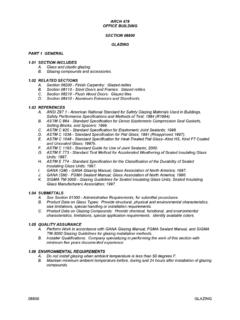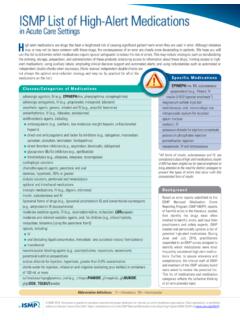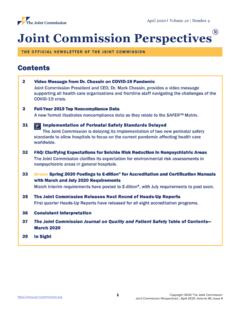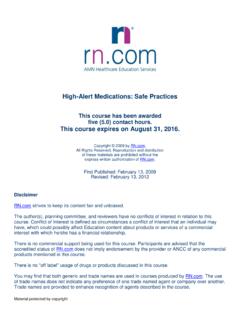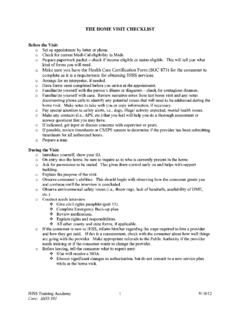Transcription of Lesson 3: Calculations used when compounding medications
1 Lesson 3: Calculations used when compounding medications Pharmacists and pharmacy technicians all compound medications in one way or another, at least at some point in their careers, and you will try your hand at it soon, if you have not already. The most common compounding you are likely to do is preparation of intravenous (IV) solutions. This compounding is fairly straightforward and will involve primarily proportional Calculations . There will be times when you will need to determine the osmolarity of an IV. solution. Finally, you may need to change the concentration of an already-mixed IV solution, so you will need to know how to dilute or concentrate that solution. You will likely also compound medications for topical application or administration via some body orifice. There are Calculations you will need to perform to ensure that ingredients are properly weighed and that solutions for mucous membranes are isotonic, so they do not harm tissues.
2 You may have to dilute or concentrate a topical or other compounded product. You will need to understand how buffers work, when they are needed, and be able to perform buffer solution Calculations . The purpose of this Lesson is to review all of the Calculations you will need in order to do those things just described, which include: proportional Calculations determination of osmolarity isotonicity Calculations dilution and concentration of previously-prepared medications aliquots buffer system Calculations . Common lingo used in the IV room There are a few important terms that you need to become familiar with prior to moving on to Calculations in this Lesson . The first one is stock solution. A stock solution is the most concentrated form of a drug that you can put your hands on. Sometimes a stock solution will be pure drug in powder or crystalline form (I know, I know: it's not a solution then, but people may call it that, anyway).
3 At other times it will be a liquid or a solid paste or cream. The second term you will need to understand is the word bag. In the world of pharmacy, a bag is a flexible, soft plastic container filled with a sterile fluid (it looks vaguely like a heavy-duty, half-empty water balloon). Bags often have liquid forms of medication added to them (which are not-so-imaginatively referred to as additives ), and the contents of the bag are then infused straight into a patient's vein (through tubing that is usually connected to a pump). Different sizes of bags will hold different volumes of fluid. Bag volumes used commonly contain 50ml, 100ml, 250ml, 500ml, or 1000ml amounts of fluid, commonly D5W or NS. Larger bags of fluid (250ml, 500ml, and 1000ml) will have medication added to them which will infuse in over a long period of time (hours), and are often referred to as drips.
4 Little bags (50ml, 100ml bags) are often called IV piggybacks, abbreviated IVPB, since they are piggybacked onto the tubing of a solution already infusing into the patient. Use of these small bags for medication administration has declined over the past decade in favor of syringes, which are placed in an pump for medication administration. Another term you will need to know is standard concentration. A standard concentration is a set volume and concentration of a commonly-made medication . The medication concentration and volume is pre-determined by nursing and pharmacy, and then all bags of that medication are prepared based on the specified recipe. To illustrate how standard concentrations work, let's say that a physician decided that a patient needed an intravenously- administered drug called dopamine. The physician would just write the word dopamine on the order, plus the desired infusion rate, for example 5 mcg/kg/minute, and the pharmacy will automatically place 400mg of dopamine in a 250ml bag of D5W.
5 Every institutional and home health care pharmacy will have available a list of standard concentrations for intravenous medication infusions. An example of a list of standard concentrations such as might be found in a hospital can be seen in the box below. Some standard concentrations are so standard between pharmacies that manufacturers have decided to prepare and market them commercially. For instance, when I was back in pharmacy school (yes, dinosaurs were extinct by then), we would prepare a lidocaine drip by placing 2g of lidocaine in a bag containing 500ml D5W. In the mid- 80s, manufacturers started selling a pre-mixed lidocaine bag at the same concentration, so if you work in a hospital pharmacy you will probably never need to mix this particular lidocaine drip. It is important to understand what standard concentrations are, because a doctor or nurse may ask you to double concentrate a drip.
6 This means you will have to prepare the drip at double the standard concentration. An example of a list of standard concentrations for a hospital. aminophylline 250mg/250ml D5W. dobutamine 250mg/250ml D5W. dopamine 400mg/250ml D5W. heparin 25,000 units/500ml D5W. insulin 25 units/250ml NS. lidocaine 2g/500ml D5W. magnesium 40g/500ml D5W. nitroglycerin 50mg/250ml D5W (glass bottle). nitroprusside 50mg/250ml D5W (wrap). oxytocin 30 units/1000ml procainamide 1g/250ml D5W. Proportional Calculations You will use proportional Calculations a lot in pharmacy, especially in the IV room. This is great, because you already know how to do these types of Calculations . Proportional Calculations involve using an available drug concentration and a desired final drug amount (in either weight or volume) to determine the amount of each individual ingredient to add.
7 Just like that. If you cook, you've probably done proportional Calculations , even if you cook using only a can-opener and a microwave. Red Alert!! An important message regarding proportional Calculations . Some students try to do proportional Calculations using a series of Calculations that look like this: a = x solving for x by multiplying (a)(c) and dividing by (b). b c If this is the way you are used to doing proportional Calculations , then realize that although you can get the correct answer this way, it is also possible to get the incorrect answer. This is particularly true if you don't write out the units for (a), (b), and (c), and if there other variables such as (d) and (e) involved. Because you are dealing with medications that could harm and in some cases even kill patients if the dose is miscalculated, you must use a method that will allow you to get the right answer every time.
8 If you didn't learn about dimensional analysis in your high school mathematics classes, it would be in your best interest to learn it now. Dimensional analysis is a method of checking an equation or solution to a problem by the way you set up the dimensions (units of measurement). If the two sides of an equation do not have the same dimensions, the equation is wrong. If they do have the same dimensions, then the equation is set up correctly. (I learned about this in high school, but not by the fancy name. It was called the make sure all your units cancel out, leaving the ones you want method. I think. Or maybe Mr. Kays told us the name and I wasn't listening. Always a possibility.) This is how it works: 1. Write out your final units (the units you would like to arrive at) on the right hand side of the page first. Leave a small space to the left, and then write an = sign.
9 2. On the left hand side of the page, begin to line up all of your available data. Be sure to include a unit for every number. If you're dealing with more than one drug or drug strength, assign a drug name to all necessary units. 3. Flip-flop proportions as needed so that the units cancel out. Make sure that all possible units cross out. If you have done it correctly, you will end up with the same units in the numerator (and denominator, if appropriate) of the final units on the right-hand side of the equation. If you have additional units left that have not cancelled out, then you have missed an important dimension or included an unnecessary one. 4. Perform your Calculations . 2. If you do this, you can feel comfortable that your answer is correct, as long as you punched the correct numbers on your calculator ( always double check, a motto to live by ).
10 You can see an example of the above steps in Lesson 2 and you will see more in this Lesson . Again, this is called dimensional analysis and is vitally important if you intend to get the right dose to the patient. First, do no harm.. Back to proportional Calculations in the IV room. Most commonly, you will usually be measuring out calculated volumes of stock solutions and adding them to some fluid (usually NS or D5W), producing more dilute solutions of drugs intended for administration to patients. Let's look at some examples: An easy example. You need to mix syringes filled with 1g cefazolin in 20ml diluent. Your stock solution contains 200mg cefazolin/ml. You want to know how many milliliters of the stock solution you will need to draw up and place in an empty, sterile 20ml syringe (and then you will add diluent to the syringe to fill it up the rest of the way to 20ml).

